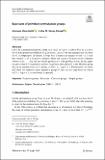Files in this item
Base sizes of primitive permutation groups
Item metadata
| dc.contributor.author | Moscatiello, Mariapia | |
| dc.contributor.author | Roney-Dougal, Colva M. | |
| dc.date.accessioned | 2021-08-11T10:30:06Z | |
| dc.date.available | 2021-08-11T10:30:06Z | |
| dc.date.issued | 2021-08-05 | |
| dc.identifier | 274764761 | |
| dc.identifier | 9eef3bc0-c302-43c2-aa58-93da4f1bbb18 | |
| dc.identifier | 85111934239 | |
| dc.identifier | 000681580500001 | |
| dc.identifier.citation | Moscatiello , M & Roney-Dougal , C M 2021 , ' Base sizes of primitive permutation groups ' , Monatshefte für Mathematik , vol. First Online . https://doi.org/10.1007/s00605-021-01599-5 | en |
| dc.identifier.issn | 0026-9255 | |
| dc.identifier.other | ORCID: /0000-0002-0532-3349/work/98487623 | |
| dc.identifier.uri | https://hdl.handle.net/10023/23758 | |
| dc.description | This work was supported by: EPSRC Grant Numbers EP/R014604/1 and EP/M022641/1. | en |
| dc.description.abstract | Let G be a permutation group, acting on a set Ω of size n. A subset B of Ω is a base for G if the pointwise stabilizer G(B) is trivial. Let b(G) be the minimal size of a base for G. A subgroup G of Sym(n) is large base if there exist integers m and r ≥ 1 such that Alt (m)r ... G ≤ Sym (m) \wr Sym (r), where the action of Sym (m) is on k-element subsets of {1,...,m} and the wreath product acts with product action. In this paper we prove that if G is primitive and not large base, then either G is the Mathieu group M24 in its natural action on 24 points, or b(G) ≤ ⌈log n⌉ + 1. Furthermore, we show that there are infinitely many primitive groups G that are not large base for which b(G) > log n + 1, so our bound is optimal. | |
| dc.format.extent | 33 | |
| dc.format.extent | 442728 | |
| dc.language.iso | eng | |
| dc.relation.ispartof | Monatshefte für Mathematik | en |
| dc.subject | Primitive groups | en |
| dc.subject | Base size | en |
| dc.subject | Classical groups | en |
| dc.subject | Simple groups | en |
| dc.subject | QA Mathematics | en |
| dc.subject | T-NDAS | en |
| dc.subject.lcc | QA | en |
| dc.title | Base sizes of primitive permutation groups | en |
| dc.type | Journal article | en |
| dc.contributor.sponsor | EPSRC | en |
| dc.contributor.institution | University of St Andrews. Pure Mathematics | en |
| dc.contributor.institution | University of St Andrews. St Andrews GAP Centre | en |
| dc.contributor.institution | University of St Andrews. Centre for Interdisciplinary Research in Computational Algebra | en |
| dc.identifier.doi | https://doi.org/10.1007/s00605-021-01599-5 | |
| dc.description.status | Peer reviewed | en |
| dc.date.embargoedUntil | 2021-08-05 | |
| dc.identifier.grantnumber | EP/M022641/1 | en |
This item appears in the following Collection(s)
Items in the St Andrews Research Repository are protected by copyright, with all rights reserved, unless otherwise indicated.

